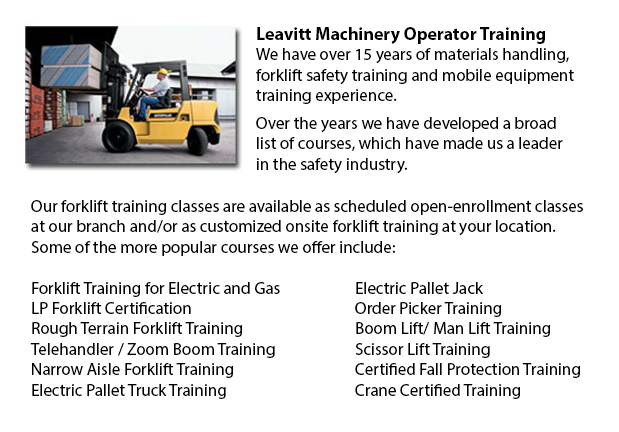
Brampton Forklift Training Schools - Have A Safe And Efficient Work Area With Our Forklift Training Schools
Are you searching for work as a driver of a forklift? Our regulatory-compliant mobile equipment operator training offers instruction in types of forklifts, pre-shift check, fuel types and dealing with fuels, and safe utilization of a forklift. Practical, hands-on training assists participants in acquiring fundamental operational skills. Course content comprises existing regulations governing the operation of lift trucks. Our proven forklift courses are designed to provide training on these types of trucks: narrow isle forklift, counterbalanced forklift and powered pallet truck.
While the forklift is in operation, do not lower or raise the forks. Loads should not extend higher than the backrest. This is because of the risk of the load sliding back in the direction of the operator. Inspect for overhead obstacles and ensure there is plenty of clearance prior to lifting a load. Stay away from overhead power lines. When the load is raised straight up, tilt it slightly back.
While the load is lifted the forklift would be less steady. Make certain that no pedestrians cross under the elevated fork. The operator should never leave the lift truck when the load is raised.
While handling pallets, forks should be level and high enough to go into the pallet and extend all the way below the load. The fork's width should provide equal distribution of weight.
Before loading or unloading the truck, chock the wheels and set the brakes. Floors have to be strong enough to support the weight of the load and the forklift combined. Fixed jacks can be installed to support a semi-trailer that is not attached to a tractor. The entrance door height should clear the forklift height by a minimum of 5 cm. Edges of rail cars, ramps and docks should be marked and avoid them.
-
Brampton Aerial Boom Lift Ticket
Brampton Aerial Boom Lift Ticket - Aerial lift trucks might be used to accomplish several different tasks executed in hard to reach aerial places. Many of the tasks associated with this style of jack include performing routine maintenance on building... More -
Brampton Aerial Lift Train the Trainer
Brampton Aerial Lift Train the Trainer - The Aerial Lifts Train the Trainer Certification Program would teach trainers how to efficiently train operators in safe industrial mobile equipment operation. Trainers are provided with in-depth instruction o... More -
Brampton Zoom Boom Training
Brampton Zoom Boom Training - Zoom Boom Training is intended to train operators on variable reach forklifts. The goals of the training are to be able to impart an understanding of the physics of the machinery, and to be able to outline the operator's... More -
Brampton Heavy Equipment Operator Training
Brampton Heavy Equipment Operator Training - Heavy equipment operator training facilities that provide good standards within the industry, providing field performance work and additional machinery training are really sought after training features. S... More -
Narrow Aisle Forklift / Order Picker Training / Electric Pallet Jack / Electric Pallet Truck Training in Brampton
A pallet haul is equipment built in particular for moving pallets of irregular weights and dimensions. They may be used in conjunction with cranes, forklifts and other heavy duty equipment as an appendage piece or to be employed on their own. Pallet... More -
Brampton Overhead Crane Safety Training
Brampton Overhead Crane Safety Training - Overhead crane safety training equips operators with knowledge and skills regarding crane safety measures, accident avoidance, materials handling, and equipment and stock protection. Trainees will learn the k... More -
Brampton Crane Safety Training
Brampton Crane Safety Training - Companies and crane drivers have to know the problems associated to crane safety. Legislation provides rules for the safe maintenance, operation and inspection of lifting machines across North America. Crane Safety co... More -
Brampton Telehandler Training
Brampton Telehandler Training - Telescopic handlers normally known as telehandlers for short, are a really popular piece of heavy construction machinery. They are usually utilized in the construction and agricultural trades. These machines have farth... More

Forklift Certification Brampton
TOLL FREE: 1-888-254-6157
Brampton, Ontario
forkliftcertificationbrampton.com
Email Us
About Us


